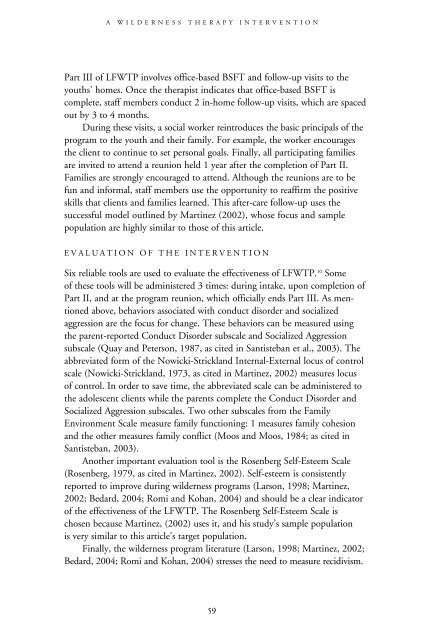2006 - School of Social Service Administration - University of Chicago
2006 - School of Social Service Administration - University of Chicago
2006 - School of Social Service Administration - University of Chicago
Create successful ePaper yourself
Turn your PDF publications into a flip-book with our unique Google optimized e-Paper software.
A WILDERNESS THERAPY INTERVENTION<br />
Part III <strong>of</strong> LFWTP involves <strong>of</strong>fice-based BSFT and follow-up visits to the<br />
youths’ homes. Once the therapist indicates that <strong>of</strong>fice-based BSFT is<br />
complete, staff members conduct 2 in-home follow-up visits, which are spaced<br />
out by 3 to 4 months.<br />
During these visits, a social worker reintroduces the basic principals <strong>of</strong> the<br />
program to the youth and their family. For example, the worker encourages<br />
the client to continue to set personal goals. Finally, all participating families<br />
are invited to attend a reunion held 1 year after the completion <strong>of</strong> Part II.<br />
Families are strongly encouraged to attend. Although the reunions are to be<br />
fun and informal, staff members use the opportunity to reaffirm the positive<br />
skills that clients and families learned. This after-care follow-up uses the<br />
successful model outlined by Martinez (2002), whose focus and sample<br />
population are highly similar to those <strong>of</strong> this article.<br />
EVALUATION OF THE INTERVENTION<br />
Six reliable tools are used to evaluate the effectiveness <strong>of</strong> LFWTP. 10 Some<br />
<strong>of</strong> these tools will be administered 3 times: during intake, upon completion <strong>of</strong><br />
Part II, and at the program reunion, which <strong>of</strong>ficially ends Part III. As mentioned<br />
above, behaviors associated with conduct disorder and socialized<br />
aggression are the focus for change. These behaviors can be measured using<br />
the parent-reported Conduct Disorder subscale and <strong>Social</strong>ized Aggression<br />
subscale (Quay and Peterson, 1987, as cited in Santisteban et al., 2003). The<br />
abbreviated form <strong>of</strong> the Nowicki-Strickland Internal-External locus <strong>of</strong> control<br />
scale (Nowicki-Strickland, 1973, as cited in Martinez, 2002) measures locus<br />
<strong>of</strong> control. In order to save time, the abbreviated scale can be administered to<br />
the adolescent clients while the parents complete the Conduct Disorder and<br />
<strong>Social</strong>ized Aggression subscales. Two other subscales from the Family<br />
Environment Scale measure family functioning: 1 measures family cohesion<br />
and the other measures family conflict (Moos and Moos, 1984; as cited in<br />
Santisteban, 2003).<br />
Another important evaluation tool is the Rosenberg Self-Esteem Scale<br />
(Rosenberg, 1979, as cited in Martinez, 2002). Self-esteem is consistently<br />
reported to improve during wilderness programs (Larson, 1998; Martinez,<br />
2002; Bedard, 2004; Romi and Kohan, 2004) and should be a clear indicator<br />
<strong>of</strong> the effectiveness <strong>of</strong> the LFWTP. The Rosenberg Self-Esteem Scale is<br />
chosen because Martinez, (2002) uses it, and his study’s sample population<br />
is very similar to this article’s target population.<br />
Finally, the wilderness program literature (Larson, 1998; Martinez, 2002;<br />
Bedard, 2004; Romi and Kohan, 2004) stresses the need to measure recidivism.<br />
59
















